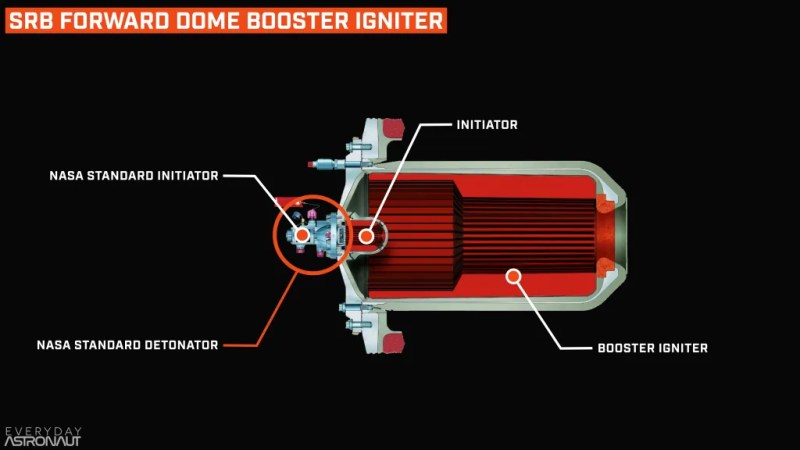Rockets are conceptually rather simple: you put the pointy bit upwards and make sure that the bit that will go flamey points downwards before starting the engine(s). Yet how to start each rocket engine type in a way that’s both safe and effective? Unlike in the Wile E. Coyote cartoons, real-life rocket engines do not have a fuse you light up before dashing off to a safe distance. Rather they use increasingly more complicated methods, which depend on the engine type and fuels used. In a recent article written by [Trevor Sesnic] with accompanying video featuring everyone’s favorite Everyday Astronaut [Tim Dodd], we’re taken through the intricacies of how flamey ends are made.
The least complicated are probably solid rockets, which come with all of the fuel and oxidizer stacked and ready for the ignition source. While a small hobby rocket would happily ignite from just a spark, by the time you have an SRB the size of those strapped to a Shuttle’s main tank or to the SLS stack, you need something a lot beefier. On the STS & SLS SRBs this starts with the NASA Standard Detonator, which ignites a pyrotechnic charge that ignites propellent down the length of the SRB and ultimately starts it.
For liquid rocket engines things rapidly get more complicated, with hypergolic propellants such as hydrazine being the easiest and self-igniting. From there it escalates into cryogenic liquids, the need to precondition the engine, bootstrapping turbo pumps, and the application of the ignition source as fuel is being mixed and floods the combustion chamber. For the SpaceX Merlin engine, this ignition source is a pyrophoric chemical called TEA-TEB which ignites on contact with oxygen, while other engines use spark igniters, pyrotechnics, and so on.
Most exciting is the part where the ignition has to take place in space, which is something that is a well-known issue for new rockets and their second and third stage engines, and is an essential part of reusable rockets that are supposed to gently touch down using propulsive landing. All in all an excellent crash course on a topic that is often neglected.

















Obligatory recommendation to read “Ignition!” by John D. Clark.
$13 Kindle, or $579 hardcover… Which to buy, which to buy 😂
$30 Softcover. You then have something both reasonably affordable and (importantly) tangible.
Buy? Just visit the internet archive for a copy: https://archive.org/details/ignition_201612
Thanks. Has an interesting prefaces as well.
That is a very good video. I saw it about a month ago. It’s long, but well worth watching.
A month? That’s a neat trick. Where did you get the time machine? The video was made ten days old.
Maybe a patreon sponsor?
Turbo-pumps that control an engine that controls the turbo-pumps, all of which need to operate in harmony under lots of different conditions: it’s enough to make your head spin.
Systems like that are why feedback loops scare me. Its part of why I insist on having mechanical fuel shutoff valves on any diesel engine with a turbocharger. I’ve seen turbo’s crumple and eat air intake “brakes” like toddler going after cotton candy.
Don’t get me wrong, self balancing systems are awesome, especially when you have radically changing conditions like starting at sea level air pressure and ending in space. They just make me extremely cautious.
After reading Wolfram’s explanation of LLMs and neural nets this morning and watching this this evening, my mind is properly boggled.
I never cease to be amazed at just how clever some people are. An excellent exposition, thank you.